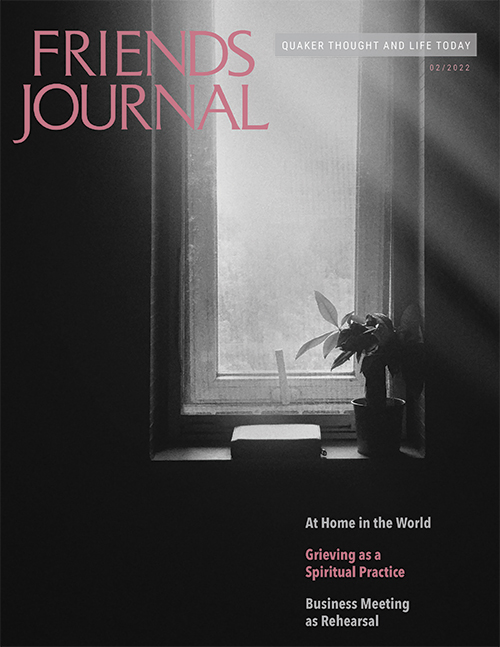Correction
The credit for the image on page 6 of the January issue misidentified it as a “Painting by Frederick S. Lamb.” The image is not a painting but a photo of a portion of Frederick Stymetz Lamb’s stained-glass portrait of William Penn (Presentation Window, “William Penn, Peace Movement, Pennsylvania,” ca. 1905, held at Brooklyn Museum). Via commons.wikimedia.org.
A double-minded person
It seems to me that meetings could use Trudy Bayer’s “Rethinking William Penn” (FJ, Jan.) to begin a discussion about many issues: Should we continue to view Penn and other historical figures as “products of their times”? If so, are we assuming that most people back then approved of slavery or perhaps didn’t care? If we choose to deepen our understanding of Quaker history, how do we make amends for any abuses we might uncover? Who continues to suffer (or profit) from past abuses? Are apologies enough? Even if Friends cannot agree on these issues, the discussions would be worth the challenge.
Helen Fox
Bokeelia, Fla.
A double-minded person is unstable in all his ways. Clearly, William Penn reflected how someone can say we are equal and have the same measure of Light/God and yet not demonstrate it through one’s actions. Had I been born in Willam Penn’s era he would have wanted free labor from me for a lifetime. Having his name removed from “our” D.C. building brings me much joy. Who knows, twenty-second-century citizens may say none of this matters and place his name back on the building. In the meantime let’s be fair and think of Quakers who may actually appreciate not having his name identified on the building. To say he encouraged tolerance of all is laughable and has nothing to do with being “woke” or exercising “cancel culture.”
Debbie Ramsey
Baltimore, Md.
I am reminded that “heroes” are just folks; it is a grave mistake to paint any of us with a sort of sainthood. My childhood hero was Dr. King, and with age I am able to see him as a man with great vision, a beautiful voice, and, of course, some of the flaws that we as humans carry with us. It does not diminish my love of his message, and the hope that he gave us.
Kathryn McCreary
Orland, Calif.
Erasing history?
I am somewhat surprised to realize that many modern Friends may not know anything of the history of Quakers and enslavement (“Flawed Quaker Heroes” by Kathleen Bell, FJ Jan.)
Have Friends heard about John Woolman, the most well-known of the early Friends opposed to slavery? Have they somehow missed knowing that Woolman’s written and traveling ministry was addressed almost entirely to Quakers who held people in bondage in America—and at the end of his life to Quaker merchants in England deeply involved in the Atlantic triangle slave trade?
Rachel Findley
Richmond, Calif.
My concern with folks erasing other folks of their time and place in history is: what will the next generation say of us doing this erasing? I don’t know perfect people. And, no matter how I try, I know that I will not be perfect.
Regina St. Clare
Freehold, N.J.
Changing the name of something is not “erasing history.” One does not learn history from the name of a room. One only learns who is revered by the people of the present. William Penn already has a whole state named after him. If Friends want to wrangle with his history in an authentic way, I’m sure we can find more meaningful ways than slapping a name on a door.
Vonn New
Ajijic, Mexico
Whilst I gained much from Katherine Bell’s article on William Penn and her critique of the sentimental mythmaking that accompanies much Quaker discussion of slavery, history complicates the picture even more than she presents. Mary Fisher, for example, is not a good figure to contrast with William Penn. Although she came from a working-class background, she ended her days in Charleston, South Carolina, a reasonably wealthy individual. In her will of 1698 she left to one of her daughters an “Indian Girle Slave named Rayner.” And whilst it is right to note that Olaudah Equiano had to buy his own freedom from the Quaker Robert King, according to Equiano’s An Interesting Narrative—the 1789 account of his own life that was so crucial in mobilizing the abolitionist cause—even he took part in buying enslaved Africans and took on the role of an overseer on a plantation after he became free and before he became a committed abolitionist.
Justin Meggitt
Cambridge, UK
Representation
Why are there no BIPOC (Black, Indigenous People of Color) Friends on the cover of the January issue on Quaker Heroes? I understand from the editor’s letter that the article about early Black Friends acknowledges there are no surviving images of the Friends discussed, but reporting on historic marginalization and repeating marginalization are two really different things. When we use past discrimination to justify current absence, we are still part of the same white supremacist cycle. On social media you ask, how can we “prepare the way for the prophetic activists of tomorrow?” Part of that work means centering the images of diverse prophetic activists today, not just recentering the ones we know and recognize (i.e. William Penn is in front and the only one named on the cover, obscuring the names of the two white women.)
Imagery has a profound impact on shaping how we understand the world and how we can imagine ourselves in it. This cover reinforces that Quakers are all white, older, etc. When I think of the Friends, both past and present, whom I look to as guides and models for how to truly live our faith, they span many ages, races, genders, and other identities. I am printing out some of their images to paste over the cover of this issue of Friends Journal that will arrive at my home, to ensure that my child and I don’t unconsciously absorb the false messages of your cover about who can be a Quaker or a Quaker hero.
Two sets of questions that we use in our work in New England Yearly Meeting are: (1) To whom is this event/message/opportunity accessible? To whom is it not? How do we know? (2) Who does this event/message/opportunity center? How do we know?
As someone who is privileged and centered by society for a number of identities I embody, I often don’t notice when I am unconsciously re-centering people who share my same privileged identities. Even asking the question of who I am centering is not always enough, but it does get me moving in the right direction and seeking more input and feedback. I also embody some identities that are targeted by society and systems of oppression, even among Friends. Seeing those aspects of myself recognized and valued is incredibly important, and was almost completely absent from my Quaker childhood.
Please, show us heroic Quakers of many backgrounds and identities, invite artists to create images where none were recorded or have been lost. We all belong in the beloved community, and must address the exclusion and harm that deny this truth and limit our vision for who we are and can be as Friends.
Lisa Graustein
Dorchester Center, Mass.
Representing heroes can be fraught. One of the most intriguing stories in the January issue is the lone Black woman maintaining Quaker worship in a mostly abandoned meetinghouse in nineteenth-century Carteret County, North Carolina. Ean High paints the picture in “Significant Silence”: she had probably been enslaved at birth by White Friends, who had left her over two decades earlier when they decamped en masse for Ohio. She wasn’t on any membership rolls. There are no formal records of her. The scant knowledge we have all comes from the published journal of a traveling White minister who was passing through and didn’t bother to record her name. We have no known image of her.
When we were putting together our January cover, we hit on a baseball-card motif: we’d show some of the people featured in this issue. Some were heroes, others anti-heroes (at least as portrayed by this month’s authors). We had no easy way of portraying Ean High’s protagonist. Under the pressure of deadlines, we settled on using the images of three other Friends profiled in the issue.
As Lisa points out, the three were all White. Of course we had known that at press time, but seeing it afresh it became obvious that for someone viewing the issue and seeing only the cover, we were implying that only White Friends are worthy of heroic stature. Images are powerful. We were ironically reinforcing the historic injustice and invisibility that our articles call out against. We are sorry for perpetuating this impression.
Martin Kelley for the FJ editorial team
Philadelphia, Pa.
Remembering Elise Boulding
Elise Boulding taught me an important lesson that I hope will spread out to the rest of the world (“The Life and Conduct of Elise Boulding” by Barbara M. Birch, FJ Jan.). Not only was she beautifully aware of the global nature of humanity but of the revolutionary nature of women’s importance in human affairs. She had discovered that it was not necessary to organize human interaction in a male-oriented pyramidal competitive pattern. She insisted in meetings happening in a circle, with empathetic, democratic sharing of ideas. This taught me that we need to be drawing on the deep resource of women’s problem-solving at the highest levels of government and commerce. As girls and women follow the model of people like Elise Boulding this becomes more and more possible.
Chris King
Ojai, CA
Thank you for this essay on Boulding. Her writings about family and her encouragement to more radically include children and youth in Quaker community have been important to my work, and given me hope.
Melinda Wenner Bradley
Glen Mills, Pa.
Thanks Barbara for your wonderful synopsis of another of the many facets of the life and work of Elise Boulding, whose work continues to inspire so many of us. And thanks for including my previous work in your article. Working with Elise for so many years and studying her life, coupled with many hours of both formal as well as informal conversations over meals was truly transformative and has influenced my own life and work ever since. My hope is that future generations of Quakers and non Quakers can return again and again to her work, which can inspire so many in so many different ways.
Mary Lee Morrison
Hartford, Conn.




Comments on Friendsjournal.org may be used in the Forum of the print magazine and may be edited for length and clarity.